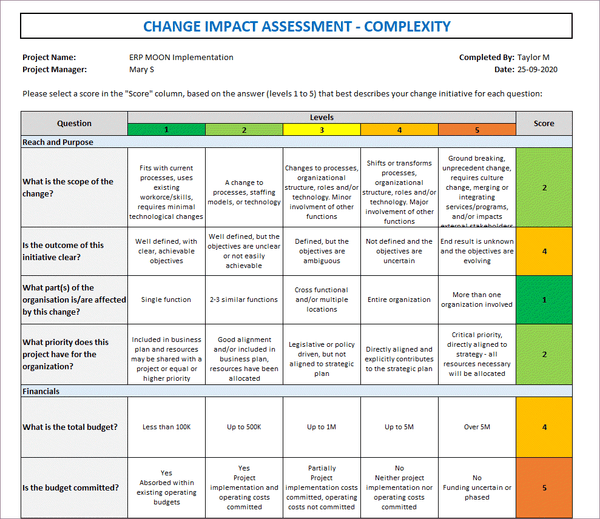Change Impact Assessment Analysis Template
Change Impact Assessment
The clue is in the name – you guessed it right: a Change Impact Assessment assesses the impact of a change initiative. This means identifying the current and future state of the organization and evaluating the extent of the change – the who, what, and how of change – that is, what it will imply for each of the different groups of stakeholders impacted.

While the nature of change might be similar, a change affecting just one team requires less effort and investment than a change impacting the entire organization. Similarly, a change in a process is perceived and managed differently than a change in working practice, as it is usually more difficult to break an old habit. This being said, all change is unique, and therefore its characteristics should be identifying and understood to allow for better preparedness and management of the change.
The Change Impact Assessment can also be coupled with a complexity assessment since complexity is one of the key drivers that will influence change in the organization. The assessment should be completed as early as possible, and it is the starting point to create the Change Management Plan since the latter should be tailored to cater to the type of change to be implemented.
What Does Change Impact Assessment Include?
While the change impact assessment can take into consideration multiple factors – ideally based on lessons learned from the organization’s knowledge database – it will usually include the following:
- Scope of Change: is this something revolutionary and risky and challenging to manage, or will this be closer to business as usual or an evolutionary change?
- Purpose of Change: how clear is the outcome to be achieved? Has it been communicated, and are the objectives defined and achievable?
- Reach of Change: will the change impact a single division/department or the full organization?
- Financials: what is the size of the budget required? Has it been committed already, or is funding still to be secured?
- Timescales: how long will the change take to implement? Does the schedule propose to represent a realistic proposition?
- Support: is this an initiative that we can do on our own, or will it require assistance from other divisions (e.g., Legal, Procurement) or even third parties?
Different answers to these questions will mean a different type of change to manage and determine if the change effort required will be low, medium, or high, allowing for better preparedness for change.

Change Impact Assessment Template
Change Impact Categories
That change impact will translate into different categories, such as:
- Structure: changes regarding team structure, reporting relationships, and approvals
- Process: changes regarding guidelines and policies that provide structure to day-to-day activities
- System: changes regarding enabling platforms, such as IT, communication channels, or templates
- Skills: changes regarding the skills and capabilities required to perform a job
- Behavior: changes regarding the attitudes and norms that form the culture of the organization.
As part of the assessment, the impact on the stakeholder groups should also be evaluated. This will ensure that no one is being left behind and will support the development of the communication plan, tailored to address each stakeholder's communication needs.
In the same vein, a full change impact assessment should contain an assessment at the process level, that is, the identification of the processes that will need to be revisited, adapted, or produced, as well as what their current state (as-is analysis) and future state (to-be analysis) looks like. This logic applies to all the categories of impact at play.
The Change Impact Assessment can be completed as a series of workshops and/or interviews. Such an approach enables the early identification of risks and better preparedness for change while creating awareness amongst participants for the upcoming change, which will later facilitate their adoption and transition to the new ways of working.
Although the Change Impact Assessment should be completed from the offset of the change initiative, it is not a one-off process. It should be revisited at regular checkpoints in the lifecycle of the project. People will have an evolving perception and attitude regarding change as it starts to be introduced; thus, the impact assessment is not static but will evolve.
Make no Mistake: no change is the same. Ensure that you assess yours before it is too late to handle it!




